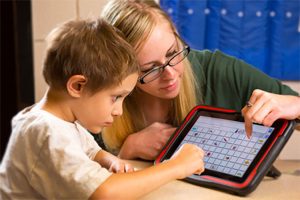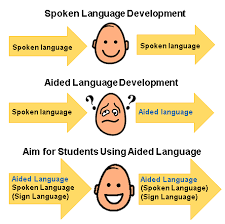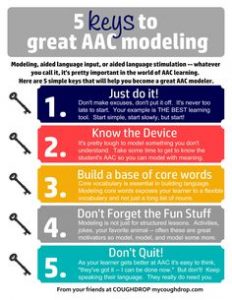Tips to Implement AAC at Home
Tips to Implement AAC at Home
-
Get help from Speech-Language Pathologists (SLP) & AAC users.
To use AAC at home, parents will often require guidance & training from speech therapists. Parent training is a very important part of an AAC implementation at home. The SLP’s help in training the parents with communication strategies that help in the use of AAC. Many times, you will find the parent support groups for AAC and also some by AAC users themselves. When you raise a question in such groups, you are sure to get some very handy information too!
2. Choose the best AAC for your child.
This is one of the most crucial steps in AAC implementation. The SLP will help you in making this decision. Your child will be assessed for their language, cognitive & physical abilities. Some robust AAC devices have options to add & customize the AAC as the child grows. It is important to see the ease of customisation for the AAC device as your child is constantly growing, thus communicative functions also improve.
-
Presume competence
When we say presuming competence, we mean that every child has something to say. And every child communicates in one way or the other. We must presume that the child is competent to communicate. There is no pre-requisite for Using an AAC. Anyone irrespective of language, cognitive or physical limitations can use an AAC. Nowadays, there are various modifications that can be created based on the child’s needs to use the AAC.
-
Modelling using aided language stimulation
We all know that children learn to speak by listening to language. When it comes to AAC users, they need to see what it looks like to communicate by using their devices. So, they need to be shown using their devices. You can introduce this by modelling. If you want to teach “WANT”, you point on the word “WANT”. This is called aided language stimulation. You don’t need to model every word that you speak. You just have to model the important words or just one level above your child’s level.
-
Create opportunities to use the AAC
Once you start modelling, use the AAC in various opportunities around you. You can start off by using it in your child’s daily routine. Your home is the best place to use the AAC as it is the most comfortable & also a natural environment. You can make a list of the different activities that your child does throughout the day. Then, list out the important words that you would want your child to learn & use. The more opportunities, the better. Here are some examples in which you can create opportunities:
- What or who your child is seeing
- What your child wants to eat/drink
- Where to put the toys/ things
- What work you are doing
- Feelings such as happy, sad, angry etc.
- Categories of words like animals, food, body parts etc.
- Action words like see, want, go, no, stop, play etc.
- Location words like up, down, in, out, over, under, etc.
- Description words like quick, slow, big, small, colours, etc.
-
Allow your child to babble
When you introduce the AAC to your child, they may not immediately start using the device meaningfully. They might tap randomly on the buttons, flip the device up & down. This is known as AAC babble. Allow them to do this. In doing so, they explore the device by playing in their own way just like how typically developing babies play with their sounds. When your child starts doing this, do not take the device away. The longer the device stays with them, the more familiar they will get.
-
Encourage your child’s attempts to use the AAC
In line with the previous point, if a child taps a button by accident, you can still add meaning to it. If they tapped on “BANANA”, you can say “Oh, you want a banana? Let me check if there are some in the kitchen”. Introduce meaning slowly using the opportunities stated above. This will help your child build language. The babbling phase won’t last for a long time. As your child understands the function of the AAC, gradually they will start using it meaningfully.
-
Always ensure consistent availability of the AAC
Learning to use an AAC requires lots of exposure to the child. Even for the parent, it can seem like a challenge. This is one of the reasons why AAC must always be available to the child so that they know how to use it in every situation. Just like how we can communicate in every situation when required of us. Only when the child has the AAC with them will they communicate. Also, make sure the device is always charged if it’s a chargeable one.
-
Have realistic expectations
Sometimes, we find ourselves having very high unrealistic ideas of how things function. Additionally, AAC is one of the most misunderstood modes of communication wherein you may assume that it gives magical results. Also, this is not true. Further, it takes time & patience to see results using AAC. Talk to your child’s SLP to know about approximately achievable goals that can be accomplished in a given timeline.
-
Embrace AAC as a family
Include family members in the opportunities. Further, children learn language from people around them. Moreover, get your family together and learn about how the AAC is used. Furthermore, when you use the device, it encourages your child to communicate using the AAC at home. In other words, as their family, it is you who can really motivate your child to communicate.
- Tips to Promote School Readiness - February 28, 2023
- Baby Sign Language - February 24, 2023
- Summer Speech Activities for Children - February 21, 2023





Leave a Comment
(0 Comments)